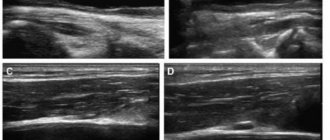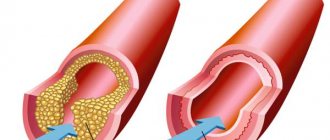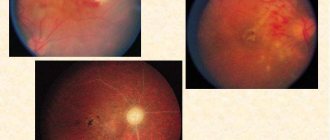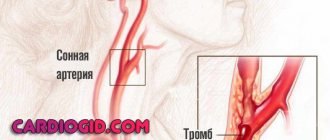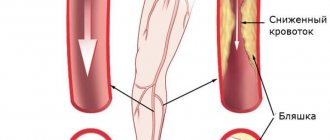Atherosclerosis of the brachiocephalic arteries is a disease in which the largest vessels of the body are clogged with cholesterol plaques. The brachiocephalic trunk arises from the aorta and is divided into several branches, including the right subclavian, carotid and paravertebral arteries.
It is this system that supplies blood to the brain and the right lobe of the shoulder girdle. Therefore, doctors warn that blockage of the brachiocephalic arteries poses an immediate threat to the life and health of the patient. Today we will talk about this insidious disease, which in the initial stages is practically asymptomatic.
Classification of forms of the disease
(Reference: narrowing of the arteries - stenosis, complete blockage - occlusion)
- stenosis and occlusion of the internal carotid artery,
- stenosis and occlusion of the common carotid artery,
- stenosis and occlusion of the vertebral artery,
- stenosis and occlusion of the subclavian artery.
Narrowing of these arteries that supply blood to the brain leads to chronic cerebrovascular insufficiency (CCI) or stroke (cerebral infarction).
KhNMK
- a state of constant lack of blood in the brain, continuous oxygen starvation of brain tissue, forcing brain cells to be in constant tension of all intracellular systems and intercellular connections, which leads to disruption of the normal functioning of both brain cells and the organ as a whole.
The main classification of chronic cerebrovascular insufficiency (CHF), used in Russia (according to A.V. Pokrovsky), contains 4 degrees:
- I degree
- asymptomatic course or absence of signs of cerebral ischemia against the background of proven, clinically significant cerebral vascular damage; - II degree
- transient ischemic attack (TIA) - the occurrence of focal neurological deficit with complete regression of neurological symptoms within up to 1 hour; transient cerebrovascular accidents (TCI) - the occurrence of focal neurological deficit with complete regression of neurological symptoms within up to 24 hours; - III degree
- the so-called chronic course of SMN, i.e. the presence of cerebral neurological symptoms or chronic vertebrobasilar insufficiency without a history of focal deficiency or its consequences. In neurological systematizations, this degree corresponds to the term “dyscirculatory encephalopathy”; - IV degree
- previous, completed or complete stroke, i.e. the existence of focal neurological symptoms for more than 24 hours, regardless of the degree of regression of the neurological deficit (from complete to no regression).
Dry statistics cannot fully reflect the tragedy of the situation when a cerebral infarction occurs - a stroke... But stroke ranks second in the structure of overall mortality of the population, second only to cardiac pathology. 35% of patients who have had a stroke die within the first month, and approximately 50% of patients die within a year, i.e. every second. Think about these numbers: stroke affects about 6 million people in the world every year, and in Russia - more than 450,000, i.e. Every 1.5 minutes, one of the Russians suffers a stroke for the first time. In St. Petersburg, 12 thousand cases of stroke are registered annually.
Vascular stenosis of the lower extremities
Stenosing atherosclerosis of the arteries of the lower extremities has symptoms similar to those in the upper extremities. In the first stages, a disorder of sensitivity and temperature of the extremities occurs. Then a pathognomic symptom appears for plaques localized on the vessels of the lower extremities, which is intermittent claudication, which is manifested by aching pain in the legs that appears while walking and disappears when stopping and resting. In advanced forms of the disease, fascial swelling of the muscles occurs, which develops into trophic disorders of the limbs, which threatens amputation.
Stroke
Stroke is the main cause of disability in the population. Only about 20% of surviving patients can return to their previous jobs. At the same time, a stroke imposes special obligations on the patient’s family members and places a heavy socio-economic burden on society.
Ischemic stroke
- This is the death of parts of the brain due to insufficient blood supply to them through the arteries. The brain receives nutrition from two carotid and two vertebral arteries. About 80% of ischemic strokes occur due to damage to the carotid or vertebral arteries in the neck. The vast majority of narrowings of the arteries arise due to the deposition of atherosclerotic plaques in the vessel wall, which not only cause insufficient blood flow to the brain, but are also destroyed with the formation of small or massive blood clots, causing either an extensive stroke or many small ones, leading to a significant decrease in intelligence and dementia.
The presence of atherosclerotic plaques in the vessels supplying the brain is often difficult to suspect, since the complaints are varied and inconsistent. The main precursors to the development of a major stroke are the so-called transient ischemic attacks (TIA), which occur when small fragments of an atherosclerotic plaque tear off and enter small vessels of the brain, causing brain death in a small area. In this case, transient paralysis of the arms and/or legs (from several minutes to several hours), speech impairment, transient or sudden blindness in one eye, memory loss, dizziness, and fainting are possible.
Presence of TIA
- This is an alarming warning signal that your brain is in serious danger and you need to undergo examination and begin treatment as soon as possible.
Modern capabilities of cardiovascular surgery make it possible to save life and improve its quality for most patients and to prevent ischemic disorders of cerebral circulation. The clinic's cardiovascular surgeons have modern equipment, unique plastic materials and surgical treatment technologies in their arsenal. In some cases, intravascular elimination of narrowing of the carotid artery is possible without anesthesia and an incision through a puncture of the artery and the introduction of a special instrument into its lumen under X-ray control.
Causes and typical patient complaints
The reasons for the development of atherosclerotic changes in the BCA are:
- high blood flow rate in the vessels, which causes damage to the inner layer of the arteries with constant high pressure;
- a large number of branches;
- many obstacles to laminar (calm, uniform) blood flow, which create branches, causing turbulence;
- impaired concentration of low-density lipoproteins (LDL);
- high levels of glucose in the blood, which also damages the vessel wall.
Typical signs of the disease include:
- a feeling of numbness in one half of the body;
- weakness and fatigue;
- reduced ability to work;
- headache;
- chronic fatigue;
- impairment of cognitive functions;
- memory loss;
- deterioration of hearing and vision.
Atherosclerosis of the brachiocephalic vessels never develops against the background of physical well-being and health. For the development of pathogenesis, provoking factors and underlying diseases are necessary:
- heredity;
- chronic and acute stress;
- smoking, alcohol abuse;
- bad eating habits: eating fatty, salty foods with low fiber content;
- limited motor activity, sedentary lifestyle;
- arterial hypertension;
- intrauterine anomalies in the development of blood vessels in the neck and head;
- male gender;
- menopause in women;
- age;
- overweight and obesity.
Basic methods of treating atherosclerosis of the brachiocephalic arteries
Unfortunately, there are no drugs yet that can “dissolve” or eliminate plaques in blood vessels. Some drugs, such as aspirin and cholesterol-lowering drugs, can only stop the growth of atherosclerotic plaques and reduce the likelihood of blood clots. The main and only effective method of treating narrowing and occlusion of the carotid, vertebral, and subclavian arteries is surgery. Numerous studies by scientists from various countries have indisputably proven the effectiveness of preventive surgical methods in preventing stroke.
Open operations can be as follows:
- classic carotid endarterectomy with artery patch plasty,
- eversion carotid endarterectomy,
- internal carotid artery replacement,
- carotid-subclavian shunting.
Minimally invasive methods:
- carotid angioplasty with stenting,
- stenting of the subclavian artery,
- vertebral artery stenting.
The choice of treatment method is based on a comprehensive examination of the patient and is prescribed based on many factors, according to strict indications based on Russian national recommendations for the management of patients with vascular arterial pathology.
Diagnostics
Before starting treatment for atherosclerosis of the brachiocephalic arteries, it is necessary to determine the degree of closure of the lumen, as well as the speed of blood circulation both before and after the problem area. The main diagnostic method used to achieve these goals is triplex scanning of the arteries. That is, conventional ultrasound examination in this case is supplemented with color Doppler radiation. The scan makes it possible to assess the condition of the cervical arteries that carry blood to the brain.
If necessary, the diagnosis of atherosclerosis of the brachiocephalic arteries can be expanded by such research methods as: duplex scanning, magnetic resonance angiography.
Diagnosis of pathology is not difficult thanks to modern equipment that allows you to view each vessel and identify the disease at the initial stage of its development.
It is important to know!
- 70% of all strokes “live” in the carotid arteries.
- If you or your relatives have experienced symptoms of CNM, stroke, TIA, do not risk your life and consult a cardiovascular surgeon and doctors at the Department of X-ray Endovascular Diagnostics and Treatment - your family needs you!!!
- Stroke can and should be prevented.
- Atherosclerotic plaques do not dissolve!!!
- The benefit of surgery is always greater than the risk associated with it.
Symptoms
Atherosclerosis of the BCA develops gradually, causing the patient to experience characteristic symptoms:
- dizziness associated with a sharp turn of the head
- itching and tingling in the arms and legs;
- sudden nausea, swaying;
- speech impairment, blurred vision, numbness;
- noise in ears;
- short-term loss of vision;
- episodic numbness of half the body.
Clinical manifestations of stenosing cerebral atherosclerosis
The presence of an atherosclerotic process in the body can be recognized by the following clinical symptoms:
- Painful sensations in different parts of the body. They appear at the first stage and indicate tissue ischemia. Patients begin to experience pain in their legs, head and neck.
- Paresthesia. This is the feeling of goosebumps crawling on the skin. A similar phenomenon occurs when small vessels that feed sensitive skin cells are blocked.
- Flashing of flies before the eyes. It appears when the atherosclerotic process has reached the choroid plexuses of the retina.
- Ringing in the ears and dizziness. Similar symptoms debut when cholesterol plaques appear in the arteries and veins of the head, reaching the vestibular apparatus.
- Ulceration of the skin of the lower extremities. Similar symptoms occur when the disease reaches the second, thromonecrotic stage. Thrombosis appears in the vascular beds of the legs with necrosis of tissue areas in which there is no oxygenation.
- Blueness of the nasolabial triangle and distal parts of the body. This symptom occurs as a result of sequential fibrosis and sclerosis of blood vessels affecting different organs. The blood is simply unable to reach distant areas, which consequently become cyanotic.
Prevention
Preventive measures must be observed by everyone, especially those who have a genetic predisposition to atherosclerosis. They are also important in preventing relapse after successful recovery. The basic rules of prevention include:
- rejection of bad habits;
- choosing a suitable sport taking into account age and health status;
- maintaining normal weight;
- avoiding overeating;
- limiting stress;
- limiting the addition of salt to the diet;
- adherence to the principles of proper nutrition.
Also, an important preventive measure is to consult a doctor in a timely manner if you suspect any health problems.
Thus, non-stenotic atherosclerosis is a serious problem associated with the formation of cholesterol plaques on the walls of the arteries. The sooner it can be diagnosed, the greater the consequences can be avoided. Treatment requires complex therapy: medication, diet therapy, and lifestyle changes.
Description
Non-stenotic atherosclerosis - what is it? Generally speaking, these are the consequences of an incorrect lifestyle. Plaques form on the surface of blood vessels, which is caused by excessive levels of “bad” cholesterol in the blood. Pathological processes do not concern the walls of blood vessels, but their openings.
Plaques, which are blood clots, are deposits of lipid tissue. With atherosclerosis, they grow inside the vessels, which impedes normal blood flow. In the non-stenotic form of the disease, they do not slow down the blood flow.
Cholesterol problems often arise in youth and remain asymptomatic for years. Symptoms begin to be actively expressed upon reaching 50 years of age. Changes in the walls of blood vessels affect various internal organs, including large, vital ones.
It is a mistake to believe that non-stenotic atherosclerosis, like other forms of the disease, affects only the elderly.
Diet therapy
Usually the diet is prescribed for life. Any form of atherosclerosis is endogenous and completely depends on the diet and lifestyle of the patient. The table below shows permitted and prohibited products.
| Allowed | Prohibited |
| Lean meats – chicken, turkey, beef | Fatty meats, lard |
| Fish | Trans fats (margarine, spread) |
| Fresh fruits, vegetables | Sausages, frankfurters, other smoked meats |
| Sea kale | Mayonnaise, all fatty sauces |
| Bran, cereals | Fast food |
| Low-fat dairy products, cheeses | Fatty dairy products, cheeses |
| Chicory, herbal teas | Baking, flour |
Fast food is considered one of the most harmful foods that provokes high cholesterol, it is especially important to give it up for life
